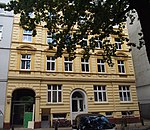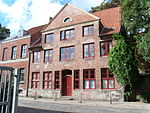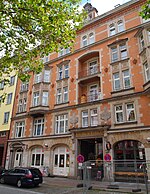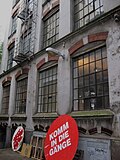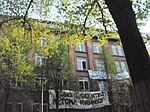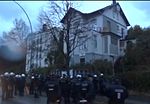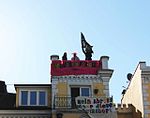Squatting in Hamburg
Squatting in Hamburg has been taking place in various forms and for various reasons since the early 1970s. As in other cities, the main motivation is to maintain buildings and affordable housing and to set up community facilities, cultural and district centers. Occupations are often directed against the urban planning and redevelopment policy of the city of Hamburg , which in this context is often referred to, according to Alfred Lichtwark , as a free and demolished city, but sometimes also directly against homeowners if tenants who are terminated and threatened with eviction do not leave the houses.
development
One of the first occupations that attracted a lot of public attention took place in April and May 1973 in Hohenfelde on Ekhofstrasse. About two hundred mostly young people wanted to set up an empty house as a student, apprentice and guest worker residence in a redevelopment area threatened with demolition, both for living and as a meeting center. After five weeks of occupation, the house was cleared by a mobile task force (MEK) from the Hanseatic city. Extensive legal proceedings were then initiated against the squatters, which in three cases led to imprisonment of 12, 14 and 16 months. Some of the squatters ( Susanne Albrecht , Wolfgang Beer , Karl-Heinz Dellwo , Bernd Rössner and three others) later joined terrorist groups such as the June 2nd Movement and the RAF and were involved in terrorist attacks in which people were also murdered.
Other occupations in the 1970s resulted from tenant conflicts. The residents of the house at Haynstrasse 1–3 in Eppendorf are often referred to as the oldest squatters in Hamburg. They joined forces as early as 1970 to prevent an impending eviction. The fifty tenants only succeeded in doing this because they organized themselves in a kind of council-democratic model, despite the most diverse political ideas that covered the entire left spectrum. In this way, the “tenants' initiative Haynstrasse” finally succeeded in 1975/1976 in securing itself with a joint tenancy agreement in such a way that any request for termination by the owner could and can continue to be defied. In addition, a guide for those affected was developed and self-published in 1976 before the work was published by a regular publisher and became a bestseller. In the meantime, however, the majority of the former tenants of the house community on Haynstrasse have long since turned into owners of the apartments there.
There was a high phase of squatting in the 1980s, which, however, often only represented a brief political flare-up. In most cases, the owners, both state and private, filed criminal charges of trespassing and the occupied houses were evacuated immediately. During this time, the Hamburg Senator for the Interior, Alfons Pawelczyk, coined a so-called "24-hour doctrine" ( Pawelczyk doctrine ): in order to prevent "Berlin conditions", every occupied house in Hamburg should be vacated within 24 hours. The occupation of Hafenstrasse from 1981, which has been legalized as a residential project since 1995, and the occupation of Rote Flora as an autonomous district center since 1989 became known beyond Hamburg . From the end of the 1980s, the actors of the squatter movement increasingly began to to organize in often publicly funded housing projects . With the help of alternative redevelopment agencies such as Stattbau Stadtentwicklungsgesellschaft mbH or the Lawaetz Foundation , negotiations were carried out with the city on vacant houses of residential groups and, after the contract was concluded, partially redeveloped. Squatting declined in Hamburg as a result.
Since 2009, in the course of the debate about gentrification , against the background of a housing shortage due to the lack of inexpensive living space, and at the same time increasing vacancies, there has been another public squatting. A highlighted example of this is the successful occupation of the Gängeviertel .
List of squatting
The following list of squatting in Hamburg enumerates publicly known squatting since the 1970s in the city of Hamburg and in its immediate vicinity in chronological order. These are political actions with different starting points, different objectives, time periods, meanings and effects. Included are both so-called repair occupations of vacant houses to preserve living space, to create public spaces or to prevent urban restructuring measures, as well as tenant battles during which tenants did not vacate a house against the will of the owner .
| House | District / place | date | annotation | Illustration |
|---|---|---|---|---|
| Haynstrasse 1–3, Hegestrasse 41 | Eppendorf | since 1970 | Described as the stronghold of the Hamburg tenant struggle , demolition prevented, collective lease agreement enforced in 1975, repeated eviction suits were unsuccessful. | |
| Karolinenviertel | St. Pauli / Karoviertel | December 1970 | Students occupy 25 vacant apartments, want to set up a district office and a kindergarten and also agree to pay rent. After criminal charges, the police cleared the two occupied houses. | |
| Old post office | Ahrensburg | April 1971 | Attempted to cast after a concert by the rock group Ton Steine Scherben , for a youth center ; the house was torn down, but an alternative was offered: the so-called barracks . | |
| Glashüttenstrasse 96 | St. Pauli / Karoviertel | January 1972 | On January 28, 1972, the district office of Karolinenviertel occupied the dilapidated building that was slated for demolition and was owned by the city and called for it to be kept as a kindergarten and rooms for youth groups. On January 31, 1972, the house was evacuated without incident. | |
| St. George's Cemetery | Hamburg-St. George | December 1972 | Students occupy the former infirmary, which has been vacant for months and is threatened with demolition, to draw attention to their housing shortage and to demand that the building be kept as a student residence. The police did not intervene at first; the city had recently sold the building to Volksfürsorge . | |
| Ekhofstrasse 37/39 | Hohenfelde | April / May 1973 | The empty house was occupied by about 200 people for five weeks. A student, apprentice and guest worker residence was to be built under the motto “Fight against rent usury ” . 500 police officers were deployed for the evacuation on May 23, 1973. The house was torn down | |
| Schröder pen | Rotherbaum | since 1974 | A tenant initiative founded in 1974 fought against eviction and demolition plans from 1980 and carried out the repair through self-help. In 1981, long-term contracts were used to regulate leasing. | |
| Old Holstenstrasse 18 | Bergedorf-Lohbrügge | January 25, 1980 | Occupation of a house planned for demolition by around 30 young people, demand for a self-managed youth center, negotiations with the owner who refrains from reporting, voluntary termination of the occupation on the same evening and conclusion with a demonstration of 300 young people to the Bergedorf town hall. | |
| Hospitalstrasse 6 | Altona old town | September 27, 1980 | The house stood empty for several years, after the occupation it was vacated immediately (Pawelczyk doctrine) and the house was demolished on September 29, 1980. | |
| Müggenkampstrasse / Methfesselstrasse | Eimsbüttel | October 11, 1980 | A demolished house (former discotheque) was occupied by around 40 young people in protest “against the misery of youth leisure time”, the police held back. Voluntary eviction after three hours, the owner then boarded up doors and windows. | |
| Kampchaussee 73 / Brink School | Bergedorf | 19./21. December 1980 | Occupation of a partially empty factory building in Kampchaussee by young people from the youth center association Our House , police evacuation on December 20, followed by a demonstration by 200 young people. On December 21, the Brink School was temporarily occupied by 150 young people from the initiative, followed by a demonstration. | |
| Billrothstrasse 55 | Altona old town | 1981 | Occupation and immediate eviction (Pawelczyk doctrine), the house was preserved and renovated. | |
| Virchowstrasse 56 | Altona old town | 1981 | Occupation and immediate eviction (Pawelczyk doctrine), the house was demolished. | |
| Kellinghusenstrasse 10 | Eppendorf | 20./21. March 1981 | Occupation of an empty house from a 150-strong demonstration train, owner: Heinz Ruppert. Police were already waiting in the house for squatters, several arrests. 200 people occupy an intersection in protest of arrests. On March 21 Another demonstration by 200 people, including many DKP supporters; while occupation of an empty house, police evacuation after 20 minutes. | |
| Virchowstrasse 65 | Altona old town | April 6, 1981 | "Secret" occupation of vacant apartments by apartment hunters, protest against the planned conversion into owner-occupied apartments. After four days hanging up banners and an invitation to the "Open House". No people will be found when the police and MEK are evacuated. | |
| Kloksweg | Eimsbüttel | 1981 | The backyard terrace was supposed to be torn down in the early 1980s, the tenants resisted the eviction, founded an association and got the city to buy the houses from the owner and keep them in this way. | |
| Amandastrasse 73 | Eimsbüttel / Schanzenviertel | April 4th 1981 | Occupation of a SAGA house planned for demolition . Occupiers are u. a. supported by Bunter List and DKP. Immediate eviction (Pawelczyk doctrine), pushing the supporters in front of the house with batons, storming over ladders, followed by a spontaneous demonstration of 300–400 people to the headquarters of SAGA, thereby destroying the window panes of banks. The house was preserved and renovated. | |
| Jenckelhaus (Max-Brauer-Allee / Holstenstrasse) | Altona old town | April 14, 1981 | The house, which is part of the former Altona hospital complex u. a. the college for social education housed, should give way to new buildings. The occupation was directed against "this clear-cut policy", over 200 students decided to "visit", around 80 people stayed for the evening. Solidarity from the teaching staff, the headmaster advocates a negotiated solution, in negotiations a demolition delay of 4 weeks is achieved. Eviction after seven hours. | |
| Green hunter | St. Pauli | May 29, 1981 | The Ein Haus für Alle ( A House for All) initiative occupied a rear building on the Grüner Jäger and called for a district center. The house was evacuated the following night (Pawelczyk doctrine). The house for everyone was later built on Amandastraße in Eimsbüttel. | |
|
Hafenstrasse St.Pauli-Hafenstrasse, Bernhard-Nocht-Strasse |
St. Pauli | from October 1981 | From October 1981 the house complex was "gradually occupied", on February 23, 1982 the first official occupation took place. In November 1987, after failed contract negotiations, so-called "Barricade Days" took place, which ended with the Dohnanyi word of honor and the renewal of the contracts. In 1995 the houses were sold to the Alternative Cooperative on the banks of the Elbe and then renovated. Today the houses exist as a residential project. | |
| Bartelsstrasse 58 | St. Pauli today Sternschanze |
1982 | Occupation and immediate evacuation (Pawelczyk doctrine) of the backyard terrace, demolished in September 1984, today an extension of the Altonaer Strasse school | |
| Chrysanderstr. 142 and Sanderstr. 19a | Bergedorf | April 3, 1982 | Occupation by young people, people looking for apartments and people to be repaired in order to criticize the destruction of living space in Hamburg; Eviction by MEK and identification treatment of the occupiers | |
| former police station 93 | Billstedt | August 7, 1982 | After a rock concert, the "Initiative for a self-administered district center Billstedt-Horn", which has been trying to find space since 1979, occupies a former police station whose tenant was a gallery owner. However, the complaint for trespassing came from the Mitte district office as the house owner. The press then reported on an action by the GAL, members of the list, including Thomas Ebermann as "ringleader"; 57 people were charged and the trial ended with a warning for all of the accused. | |
| Pinnasberg 74–76 Heidritterstrasse |
St. Pauli | 1984 | From 1984 the building complex was repeatedly occupied and immediately cleared (Pawelczyk doctrine), in 1986 contract negotiations with a house group took place, but were broken off shortly before completion. The city did not want to tolerate any further housing projects in the immediate vicinity of Hafenstrasse. The houses were occupied for the last time in August 1992, then demolished and replaced by new buildings. | |
| Jägerpassage Wohlwillstrasse |
St. Pauli | May 1, 1984 | The terrace is considered to be the oldest evidence of social housing construction in Hamburg, from 1977 renting and planned demolition: both conservationists and a group of houses campaigned for its preservation. 1982 Part of the north terrace was demolished, the south terrace was occupied for the first time on May 1, 1984 ( Association of Tenants' Self-Administration Jägerpassage ) and immediately cleared (Pawelczyk Doctrine), further occupations followed. From 1988 repair of the central terrace, from 1990 repair of the south terrace and conclusion of contract, today there is a residential project here. | |
| Fire station | Billstedt | 1984 | Casting artists to build a residential and studio building; As an alternative, the city offered the occupiers the Vorwerkstift in the Karolinenviertel , which is being renovated in-house and has been run as an artist house by Freiraum eV since 1990 . | |
| Chemnitzstrasse 3-7 | Altona old town | 1985 | Leased from the mid-1970s and scheduled for demolition, from 1985 multiple occupations, establishment of a fire station ( Café Feuerwache ), 1986 contract with the city and subsequent repairs. Has existed since as a residential project. | |
| Wohlwillstrasse 15 | St. Pauli | 1986 | "Wohnwerkstatt eV" association, owned by the ship carpentry cooperative, briefly occupied in 1986 and subsequent evacuation by a women's collective; 1988 Negotiations about the Johann Daniel Lawaetz Foundation. On January 12, 1989, the demolition was stopped by an injunction, and one day later the house was listed as a historical monument. From mid-July 1989 the restoration took place, the house was not given to the women's collective. | |
| Adolph Passage - Bernstorffstrasse 160/164 | St. Pauli | 1986 | The house should be vacated by the tenants and then demolished. The tenants resisted the eviction and were ultimately able to prevent the demolition | |
| Great freedom 73/75 | St. Pauli | 1986 | Multiple symbolic occupations of the former church building of the Altona Mennonites, the main initiator for the preservation of the building was the monument protection office; Repair from October 1988, since then residential project. | |
| Great Freedom 84 | St. Pauli | 1987 | The courtyard development is one of the last rows of stalls in St. Pauli and should be torn down. After a few symbolic occupations, the houses were renovated as a self-help project by the autonomous youth workshops. | |
| Schanzenstrasse 41a | St. Pauli today: Sternschanze |
June 27, 1987 | The backyard complex, privately owned, was first occupied in June 1987 and evacuated after two days. The subsequent occupation was tolerated, in September 1987 the houses could be bought by the "Schanze eG" founded for this purpose. Subsequent repair, since the residential project | |
| Bergiusstrasse | Ottensen | 1988 | multiple occupations of the house and immediate evictions, the house was demolished, the property was rebuilt. | |
| Laeiszstrasse 18 / Marktstrasse 95 | St. Pauli / Karoviertel | 1988 | From September 1987 the owner Nikolai Rabels tried to unlease the houses, obtained court eviction titles against the tenants and had an eviction carried out under police presence. From June 1989 the houses were occupied and cleared several times. There was a destruction of the building structure by construction workers and multiple unexplained fires. In 1996 the house in Laeiszstrasse was demolished and the house in Marktstrasse was renovated. | |
| Greves Garden Mohnhof 20 | Bergedorf | January 1989 | Occupation as a protest against the planned demolition of a historical ensemble; the house was preserved, refurbished and occupied by a residential project. | |
| Little Shepherd 46 | Eimsbüttel | May 1989 | Occupation of a row of backyards threatened with demolition ; the houses were renovated and a residential project moved into. | |
| Lobuschstrasse 28 | Ottensen | June 6, 1989 | One day occupation of house number 28 in Lobuschstrasse in Ottensen by around 30 people to point out that it was vacant since 1985, around 150 others demonstrated on the street. | |
| Knickweg 8 | Winterhude | August 1989 | It was an empty house from SAGA's municipal inventory, the occupation was vacated immediately, the house was later renovated for residential purposes. | |
| Keplerstrasse 12 | Ottensen | November 1989 | Occupation and immediate eviction, the house was then sold and renovated for residential purposes. | |
| Winkelmann'scher Hof - Tangstedter Landstrasse 509 | Longhorn | November 1989 | Symbolic occupation; today housing project | |
| Red flora shoulder blade | Altona old town today Sternschanze |
November 1, 1989 | District center, still occupied | |
| Klausstrasse 12/14 | Ottensen | December 1989 | The house was occupied by a residential project and renovated. | |
| Kampstrasse 40 | St. Pauli today Sternschanze |
5th February 1990 | The house was occupied and vacated immediately. Two days later, on February 7, 1990, the house was destroyed by arson. | |
| Sternstrasse 107 | St. Pauli today Sternschanze |
February 25, 1990 | Occupation and immediate eviction; the house was demolished and the property rebuilt | |
| Schanzenstrasse 56-62 (Lauekomplex) | St. Pauli today Sternschanze |
March 17, 1990 | The Wilhelminian style house, owned by the neighboring Hermann Laue spice factory until 1990 , fell into disrepair over the years and was partially empty. From 1990 it was occupied several times, the last occupation took place from July 25 to 27, 1992 and was evacuated. The house was extensively renovated in 1997 and the apartments were rented for a ten-year fixed rental period . | |
| Müggenkampstrasse 15 | Eimsbüttel | March 1991 | The occupation was evacuated immediately, the house torn down, the property rebuilt. | |
| Carsten-Rehder-Strasse 81–83 | Altona old town | May 1991 | Immediate eviction, the house was torn down, the property was rebuilt. | |
| Emilienstraße 31/33 | Eimsbüttel | May 1991 | Immediate eviction, the house was torn down, the property was rebuilt. | |
| Stangestrasse 10/12 | Ottensen | May 1991 | Immediate eviction, the house was refurbished for residential use. | |
| Tegetthoffstrasse 1 | Eimsbüttel | June 1991 | Immediate eviction, the house was torn down, the property was rebuilt. | |
| Budapester Strasse 8 | St. Pauli | September 7, 1991 | Multiple occupations until 1995, then the house was demolished and the property rebuilt. | |
| Ottersbekallee 10 | Eimsbüttel | June 26, 1993 | The house served as refugee accommodation until 1991, after which it was empty. The occupation was accompanied by public actions on Homeless Day : “Sleep out on Gerhart-Hauptmann-Platz - sleep in at Ottersbekallee 10”. The house was renovated and is now a student residence. | |
| Beer Palace Gustav Mahler Park / Dammtorstrasse |
Neustadt | November 1993 | Occupation to preserve the historic building that served as the provisional accommodation for the ballet school from 1978 to 1989 ; Clearance, demolition and redevelopment with the large cinema Cinemaxx | |
| Kampstrasse / corner of Schanzenstrasse | St. Pauli today Sternschanze |
May 1, 1995 | The tenants who were supposed to vacate this house because the demolition was planned tried to defend themselves with an occupation. The house was cleared, demolished and the property rebuilt. | |
| Vereinsstrasse 28 | Eimsbüttel | 1998 | Tenants of this house from the municipal portfolio should vacate it due to pending renovation work. With an occupation they obtained the promise to be able to move in again after the renovation. | |
|
Gängeviertel Valentinskamp, Caffamacherreihe, Speckstrasse |
Neustadt | August 24, 2009 | The ensemble of historic terrace houses and backyard factories owned by an investment company was to be partially demolished. It was occupied by the artist community Komm in der Gänge and bought back by the city of Hamburg. Conservation is sought. | |
|
Erotic Art Museum Bernhard-Nocht-Straße |
St. Pauli | May 30, 2010 | The historic building planned for demolition was occupied by opponents of gentrification . The evacuation took place a few hours later. | |
| Juliusstrasse 40 / corner of the shoulder blade | Sternschanze | October 16, 2010 | The Wilhelminian style house, which was only provisionally restored after being destroyed in the war, was extensively renovated in 2006 and partially rebuilt in the old style. Even after the renovations were completed, it was still empty. The private owner was charged with the misappropriation of the living space . In October 2010 it was symbolically occupied and immediately cleared. | |
| Tax office Altona / Kleine Bergstrasse | Altona old town | April 23, 2011 | The building of the former tax office, which had been vacant for several years, was occupied with the demand for a district center and cleared by the police within a few hours. | |
| Horner Landstrasse 369 | horn | November 3, 2012 | The villa, which had been vacant for several years, was occupied and cleared by a massive police operation. | |
| Bleicherstrasse 14 | St. Pauli | November 10, 2012 | The old farrier's building in the back yard was occupied as part of a tenant demonstration and the 25th anniversary celebration of the so-called barricade days in 1987 and after four hours, sometimes with massive use of pepper spray , the police cleared it. | |
| Weidenallee 52 | Eimsbüttel | April 1, 2013 | The Wilhelminian style villa was to be torn down against the wishes of the former tenants and given way to a new building with an underground car park. On Easter Monday the empty building was occupied for a short time, when the police arrived, the occupants had already left the building. In summer 2013 the house was demolished. | |
| Breite Strasse 114 and 116 | Altona | May 11th, 2013 | The two Wilhelminian-style houses were occupied and speeches made reference to the situation of the vacancy that had existed for three years and was reported by the tenants' association. After a few hours, the police force stopped the action. | |
| Marktstrasse 137 | Karolinenviertel | May 12, 2013 | The house was occupied by four people and the police cleared it that same afternoon. | |
| Lilienstraße 8 | Near the main train station | September 28, 2013 | After a large demonstration for affordable housing for everyone had taken place in the afternoon, the house was occupied in the evening. The police cleared the building within a few hours. | |
| Laeiszstraße, former elementary school | Karolinenviertel | May 1, 2014 | In the course of a demonstration under the motto “Right to the city knows no borders”, the vacant school was occupied and, in connection with the Lampedusa group in Hamburg, designated as a Refugee Welcome Center . In the evening the police issued an ultimatum to those present in the building and, with the threat of eviction, achieved the end of the operation. | |
| Breite Strasse 114 and 116 | Altona | August 27, 2014 | As part of the so-called squatting days, the building was occupied again and the police cleared it after a few hours. |
Other occupations
An alternative form of living with political and social proximity to the squatter movement are the wagon spaces , in which housing estates were mostly created from mobile construction trailers . These often arose on fallow land within the city or in the immediate vicinity of occupied or previously occupied houses. At times there were also wagon spaces that saw themselves as concrete initiatives in political disputes, so from 1979 onwards, several trailer dwellers occupied spaces in the former fishing village of Altenwerder , which was relocated for the purpose of expanding the port .
Although living in mobile homes is generally forbidden under the Hamburg Caravan Act, this type of living was and is partially tolerated. A spectacular public evacuation took place in November 2002 when the Bambule car park in the Karolinenviertel was closed.
Long-term occupations as a form of political protest went beyond house occupations in Hamburg. Weeks of church occupation were a means by opponents of nuclear power to draw attention to their protest or a means of creating public awareness and refuge for migrants threatened with deportation. Occupations of the squares were directed against building projects, for example the occupation of the Flora Park in 1991, which was intended to prevent peripheral development in favor of a district park.
In winter 2009/2010 there was a tree occupation in Gählerpark , today Emil-Wendt-Park, in Altona old town . A residents' initiative, supported by Robin Wood , built several tree houses and lived in them for three months or 105 days from the beginning of December 2009 to March 2010. They successfully protested against the felling of around 400 trees planned by Vattenfall Europe for the construction of a so-called Moorburgtrasse , a waste heat pipe for the Moorburg coal-fired power plant currently under construction . The construction work was ultimately stopped by a ruling by the Higher Administrative Court .
On October 25, 2013, in the course of the Lampedusa protests in Hamburg, a scaffolded chimney at Bleicherstraße 14 was occupied. The squatters rolled out banners with the inscription Nobody is illegal and drew attention to the situation of the refugees in a speech. The occupation lasted two days and was ended on October 27, 2013 by the occupiers themselves.
literature
- Almut Gross, Thomas Schultze: The Autonomous. Origins, development and profile of the Autonomen , Konkret-Literatur-Verlag, Hamburg 1997, ISBN 3-89458-154-9
- Michael Hermann u. a .: Hafenstrasse. Chronicle and analyzes of a conflict , Verlag am Galgenberg, Hamburg 1987, ISBN 3-925387-34-X
- Project group living in the district: The shoulder blade. A quarter changes . Hamburg 1982
- Werner Skrentny (ed.): On foot through Hamburg. 20 district tours through past and present , Hamburg 2001, ISBN 3-434-52590-4
Web links
- Hanseatic squatting. Article The time of September 21, 2009
- Right to the city
- Archive tenants help tenants
Remarks
- ↑ The city of Ahrensburg belongs to Schleswig-Holstein , as a suburb of Hamburg, the community can be seen in the context of this squatting in the cultural and political sphere of influence of the Hanseatic city.
- ↑ The occupation of the house in Lobuschstrasse in 1989 forms the starting point of the crime novel Fridays you eat fish by Bohnet Pleitgen , see Reinhard Jahn in Focus online, `` I know what you did 1989 '' , October 27, 2009, accessed on 12 . July 2013
- ↑ The directed by Skrollan Alwert as part of a work of the University of Applied Sciences Hamburg produced and widely acclaimed documentary Iridescent times portrays vividly the socio-political events around the trailer court Bambule in Karoviertel in Hamburg, with clearance of the site on 4 November 2002 reached their climax, see Shimmering Times - A Film About Bauwagen, Bambule, Senate and Opinions , accessed July 12, 2013
Individual evidence
- ^ Streets in St. Pauli , accessed on April 24, 2011
- ↑ Der Spiegel, April 30, 1973 , accessed April 24, 2011
- ↑ freie-radios.net: On the history of squatting Hamburg Ekhofstraße. Retrieved June 9, 2020 .
- ↑ Cf. Natias Neutert : The tenant uprising in Hamburg . In: Der Stern , No. 25. v. June 10, 1976.
- ↑ Squatters with gray hair . FAZ article of December 13, 2007 , accessed on April 24, 2011.
- ↑ Tenancy law for tenants. Legal advice on self-help. Ed., Tenants' initiative Eppendorf; Eimsbüttel; Initiative Committee Arbeiterhilfe eV (IKAH), Association of Democratic Jurists (VDJ)
- ^ Stattbau Hamburg: About us , accessed on April 24, 2011
- ↑ Spiegel online from September 8, 2011, Squatted houses remain self-administered: Sekt mood in Hamburg's Gängeviertel , accessed on July 13, 2013
- ↑ Hayn-Hegestr.de: History - History of the tenant community. Retrieved June 9, 2020 .
- ↑ Hamburger Abendblatt, December 2, 1970, p. 4 and December 3, 1970, p. 5
- ↑ Rio Reiser: King of Germany , 1997, p. 230f .; Excerpt from: riolyrics
- ↑ Hamburger Abendblatt, 29./30. January 1972, p. 1 and January 31, 1972, p. 3
- ↑ Hamburger Abendblatt, December 5, 1972, p. 4
- ↑ Police report from 1973 on youtube: Hamburg Ekhofstrasse 1973 , accessed on April 24, 2011
- ↑ Hamburger Abendblatt, January 26, 1980, p. 3
- ↑ a b c d the thede: filmography
- ↑ Workers' Struggle , No. 187, October 20, 1980, p. 22; Hamburger Abendblatt, October 13, 1980, p. 3
- ↑ Hamburger Abendblatt, December 22, 1980, p. 3
- ↑ Abendblatt.de: Squatting: No penalties. Retrieved June 9, 2020 .
- ↑ Workers' Struggle , No. 198, March 30, 1981, p. 8
- ^ Workers' Struggle , No. 199, April 13, 1981, p. 6
- ^ Workers' Struggle , No. 199, April 13, 1981, p. 6
- ↑ Workers' Struggle , No. 200, April 27, 1981, p. 8
- ↑ St. Pauli Archive eV: In the shadow of big money. Living on St. Pauli, Hamburg 1990, p. 61
- ^ Circular letter coordination office for initiative groups of the youth center movement eV, 4/1982, p. 5, in: Archive of the German youth movement, A202, no. 893
- ^ Ebermann is also to appear in court , Abendblatt.de of February 8, 1983
- ^ Fines for the squatters in Billstedt , Abendblatt.de of February 18, 1983
- ↑ Workers' Struggle , No. 224, 23 August 1982, p. 17
- ^ Mild verdict for the squatters of Billstedt. The court issued a warning to MP Ebermann , abendblatt.de, on May 27, 1983
- ↑ St. Pauli Archive eV: In the shadow of big money. Living on St. Pauli, Hamburg 1990, p. 62; Streets in St. Pauli: Jägerpassage , accessed on April 6, 2011
- ↑ St. Pauli Archive eV: In the shadow of big money. Living on St. Pauli, Hamburg 1990, p. 66; Freiraum Foundation website , accessed on April 7, 2011
- ↑ St. Pauli Archive eV: In the shadow of big money. Living on St. Pauli, Hamburg 1990, p. 63
- ↑ St. Pauli Archive eV: In the shadow of big money. Living on St. Pauli, Hamburg 1990, p. 64
- ↑ karo4tel: Through speculation to political price , accessed on 11 April 2011th
- ↑ Hamburger Abendblatt, house occupied in Ottensen , Historical Archive No. 130 of June 7, 1989, p. 3
- ↑ Homepage Get started , accessed on April 24, 2011
- ^ TAZ article of May 31, 2010 , accessed April 24, 2011
- ^ TAZ article of October 18, 2010 , accessed April 24, 2011
- ^ NDR.de police put an end to squatting in Altona ( memento of April 27, 2011 in the Internet Archive ), accessed on April 24, 2011
- ↑ mopo.de Horn: Police vacate occupied Villa Behnke , accessed on November 10, 2012
- ↑ Elbe-Wochenblatt.de: Sleepless in Hamburg? Demonstration against rent madness ( Memento from March 4, 2016 in the Internet Archive )
- ↑ Taz: Make new out of old , accessed on April 2, 2013
- ↑ Hamburger Morgenpost: Squatting: Protest against renovation and demolition , accessed on May 15, 2013
- ↑ Utopie TV: Squatting / - animation, police operation at Breite Strasse Hamburg Altona, May 11, 2013 , accessed on May 15, 2013
- ↑ Hamburger Morgenpost: Squatting: Protest against renovation and demolition , accessed on May 16, 2013
- ↑ Hamburger Morgenpost: Demo against usury in renting in Hamburg , accessed on September 29, 2013
- ↑ Utopie TV: Squatting and Police Violence in Hamburg , accessed on September 29, 2013
- ↑ HH-Mittendrin.de: Re- use planned: Off for the Refugee Welcome Center ( Memento from May 17, 2014 in the Internet Archive )
- ↑ Squatting Days: Demo leads to squatting , right in the middle - news magazine for Hamburg-Mitte, August 28, 2014
- ↑ Article Hamburger Abendblatt of December 17, 2008: We just want to live differently ... , accessed on April 24, 2010
- ↑ Ernst Christian Schütt u. a .: Chronicle of Hamburg. 2nd updated edition. Bertelsmann Lexikon Verlag, Gütersloh / Munich 1997, ISBN 3-577-14443-2 , p. 577.
- ↑ TU-Cottbus.de: Moorburgtrasse stopped - tree occupation ended ( Memento from January 23, 2016 in the Internet Archive ) (PDF; 286 kB)
- ^ Video diary "LampedusaHH" Close combat in the name of the refugees , accessed on November 8, 2013.




